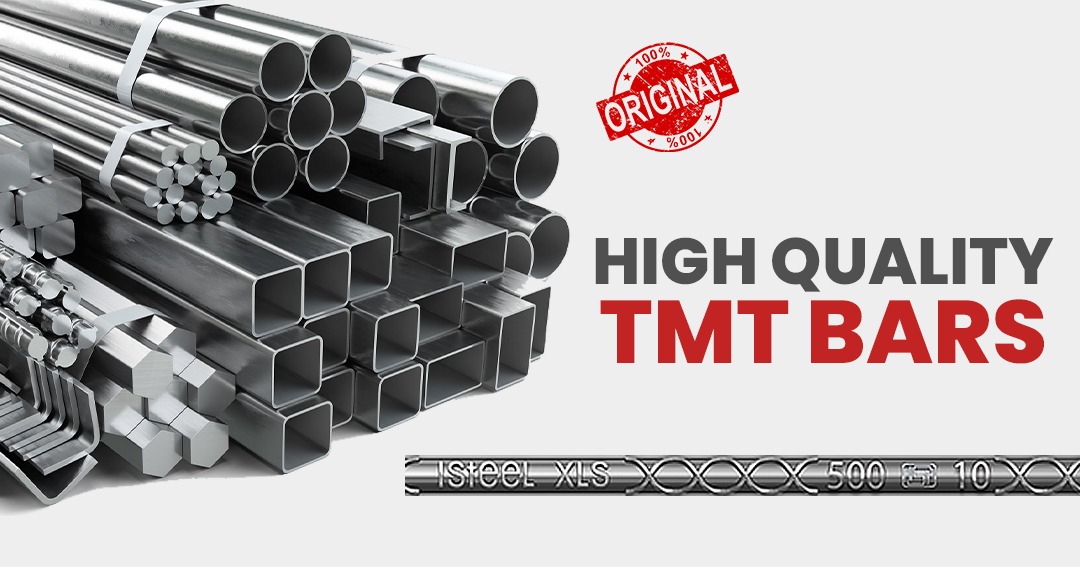The Power of Quality: How High-Quality TMT Bars Transform High-Rise Safety

- By : admin
- 0 Comments
Building a high-rise structure is no small task. The challenges of height, weight, and weather resistance make it crucial for builders to choose materials that can withstand various pressures. Among the essential materials used in high-rise construction, TMT (Thermo-Mechanically Treated) bars play a critical role. High quality TMT bars are particularly preferred in such projects because they offer the durability, strength, and flexibility needed to keep buildings safe and stable over time.
In this blog, we’ll explore why high quality TMT bars are the go-to choice for high-rise buildings, the unique advantages they provide, and how they contribute to creating secure, long-lasting structures.
1. Understanding TMT Bars: What Are They?
TMT bars are steel bars that undergo a unique process known as thermo-mechanical treatment. This process strengthens the bars by applying a mix of intense heat and cooling in rapid succession. The outcome is a steel bar with a tough outer layer and a softer core, providing both strength and flexibility. This combination is crucial in construction, especially for buildings exposed to natural forces like wind, earthquakes, and heavy loads.
High quality TMT bars stand out due to their manufacturing precision, consistency, and adherence to strict quality standards. They are crafted to meet the specific requirements of modern-day high-rise construction, offering benefits that regular steel bars might not provide.
2. The Need for High-Quality TMT Bars in High-Rise Buildings
High-rise buildings come with their own set of engineering challenges. Here’s why high quality TMT bars are so critical for them:
a. Strength to Bear Load and Pressure
High-rise structures must bear enormous weight, not only from the building itself but also from the floors above each level. High-quality TMT bars have an impressive tensile strength, allowing them to support these immense loads without cracking or breaking. Their ability to withstand such pressure makes them an essential component for high-rise construction.
b. Flexibility to Absorb Shock and Resist Earthquakes
One of the unique features of high quality TMT bars is their flexibility, which is critical for buildings in seismic zones. During an earthquake, buildings sway and experience stress. High-quality TMT bars, with their combination of a strong exterior and ductile core, absorb these shocks better than ordinary steel bars. This flexibility allows the structure to withstand seismic activity and minimizes damage.
c. Corrosion Resistance for Long-Lasting Durability
High-rise buildings are exposed to the elements, and rust or corrosion can severely weaken a structure over time. High-quality TMT bars are designed to resist corrosion, meaning they won’t rust as easily as standard steel bars. This is especially beneficial in areas with high humidity, coastal environments, or regions with harsh weather conditions. Their resistance to corrosion extends the lifespan of the building and reduces the need for frequent repairs.
d. Fire Resistance for Safety in Emergencies
Fire resistance is a critical consideration for high-rise buildings, where fire safety is a top priority. High quality TMT bars have high thermal stability, allowing them to endure high temperatures without losing their structural integrity. This fire resistance can make a huge difference in keeping the building’s framework intact during emergencies, giving occupants more time to evacuate safely.
e. Consistency and Quality Assurance
High-rise projects demand materials of consistent quality. High-quality TMT bars come with certifications and meet industry standards, providing assurance of their reliability and consistency. Builders can be confident that these bars will perform as expected, avoiding any weak points or inconsistencies that could compromise structural integrity.
3. Key Benefits of High-Quality TMT Bars in High-Rise Construction
Here are some specific benefits that high quality TMT bars offer in high-rise building projects:
Enhanced Tensile Strength and Durability
High-quality TMT bars boast a high tensile strength that allows them to support immense weight. This strength is essential for high-rise buildings, as it prevents structural failures even under heavy loads. Moreover, these bars retain their durability for decades, ensuring that the building remains stable over time.
Better Bonding with Concrete
In high-rise construction, the bond between concrete and steel is crucial. High-quality TMT bars have superior ribbed designs that enable them to bond effectively with concrete, preventing slippage. This strong bond ensures that the steel and concrete work together seamlessly, creating a robust framework that can endure stress and pressure.
Lower Maintenance Costs
Since high-quality TMT bars are resistant to corrosion and damage, buildings require less maintenance over the years. This lowers the overall costs of building upkeep, making it a smart investment for long-term stability and cost-efficiency. Builders and owners alike benefit from reduced repair expenses and extended structural lifespan.
Versatility in Design and Application
High quality TMT bars offer versatility in construction design. Builders can use them in a variety of structural components like beams, columns, and slabs, providing flexibility in architectural planning. This adaptability is especially valuable in high-rise construction, where each part of the structure needs to be carefully optimized for height and weight.
4. How to Identify High-Quality TMT Bars
Builders and buyers can look for certain factors to identify high-quality TMT bars:
- Grade: Check the grade (like Fe 500, Fe 550, etc.) to ensure it meets the strength requirements of the project.
- Brand Reputation: Opt for reputable brands known for producing consistent, certified high-quality TMT bars.
- Certification: Look for certifications and quality marks, which guarantee that the bars meet industry standards.
- Physical Inspection: High-quality TMT bars have uniform thickness and a well-defined ribbed pattern.
Conclusion
High quality TMT bars are more than just construction materials; they’re a vital part of what makes high-rise buildings strong, durable, and safe. Their superior strength, flexibility, corrosion resistance, and fire resistance make them an ideal choice for structures that face immense pressure, changing weather, and potential seismic activity. Builders who invest in high-quality TMT bars are investing in the long-term stability and safety of their projects, ensuring that these towering structures stand tall for generations to come.
